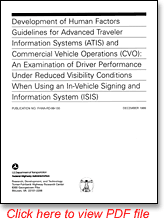Development of Human Factors Guidelines for Advanced Traveler Information Systems and Commercial Vehicle Operations: An Examination of Driver Performance Under Reduced Visibility Conditions When Using an In-Vehicle Signing and Information System
AN EXAMINATION OF DRIVER PERFORMANCE UNDER REDUCED VISIBILITY CONDITIONS WHEN USING AN IN-VEHICLE SIGNING AND INFORMATION SYSTEM (ISIS)
FIELD STUDY RESULTS WORKING PAPER
FOREWORD
This report is one of a series of nine reports produced as part of a contract designed to develop precise, detailed human factors design guidelines for Advanced Transportation Systems (ATIS) and Commercial Vehicle Operations (CVO). Among the other topics discussed in the series are functional description of ATIS/CVO, comparable systems analysis, task analysis of acceptance, and definition and prioritization of research studies.
This report documents ATIS and CVO system objectives and performance requirements. It provides basic information regarding the range of ATIS and CVO operational capabilities, a survey of ATIS and CVO systems, a preliminary set of ATIS and CVO scenarios, and a summary of system performance requirements.
Copies of this report can be obtained through the Research and Technology Report Center, 9701 Philadelphia Court, Unit Q, Lanham, Maryland 20706, telephone: (301) 577-0818, fax: (301) 577-1421, or the National Technical Information Service (NTIS), 5285 Port Royal Road, Springfield, Virginia 22161, telephone: (703) 605-6000, fax: (703) 605-6900.
Michael F. Trentacoste
Director, Office of Safety
Research and Development

PDF Version (1.6 MB)
PDF files can be viewed with the Acrobat® Reader®
TECHNICAL REPORT DOCUMENTATION PAGE
| 1. Report No. FHWA-RD-99-130 |
2. Government Accession No. |
3. Recipient's Catalog No. |
| 4. Title and Subtitle
DEVELOPMENT OF HUMAN FACTORS GUIDELINES FOR ADVANCED TRAVELER INFORMATION SYSTEMS (ATIS) AND COMMERCIAL VEHICLE OPERATIONS (CVO):AN EXAMINATION OF
DRIVER PERFORMANCE UNDER REDUCED VISIBILITY CONDITIONS WHEN USING AN IN-VEHICLE SIGNING AND INFORMATION SYSTEM (ISIS) |
5. Report Date December 1999 |
| 6. Performing Organization Code |
| 7. Author(s) Dennis J. Collins, Wayne J. Biever, Thomas A. Dingus, Vicki L. Neale |
8. Performing Organization Report No. |
| 9. Performing Organization Name and Address
Center for Transportation Research
Virginia Polytechnic Institute and State University
1700 Kraft Drive, Suite 2000
Blacksburg, VA 24061-0536
|
10. Work Unit No. (TRAIS) 3B4C |
| 11. Contract or Grant No. DTFH61-92-C-00102 |
| 12. Sponsoring Agency Name and Address
Office of Safety and Traffic Operations R&D
Federal Highway Administration
6300 Georgetown Pike
McLean, VA 22101-2296
|
13. Type of Report and Period Covered
Final Report
8/96 - 9/97
|
| 14. Sponsoring Agency Code |
| 15. Supplementary Notes
Contracting Officer's Technical Representative (COTR) -M. Joseph Moyer, HRDS; Thomas M. Granda, HRDS (formerly with SAIC)
|
| 16. Abstract
Recent technological innovations and the need for increased safety and congestion reduction on the world's roads have
led to the introduction of In-Vehicle Information Systems (IVIS). These systems will provide navigation and advisory information to drivers
while they are driving. One aspect of these systems, In-Vehicle Signing Information Systems (ISIS), would provide the warning, regulatory, and
advisory information that is currently found on road signs. These systems may be of particular benefit when external elements such as rain, snow,
or night driving reduce or eliminate the opportunity for drivers to detect road signs. This study attempts to determine what benefits, if
any, are realized by drivers using this system.
Fifty-eight drivers operated an instrumented Oldsmobile Aurora, either with or without an ISIS, under a variety of visibility
conditions. The visibility conditions included either rain or no rain, and either day or night driving. Younger drivers (18-30 years old) and
older drivers (65 years or older) took part in this study.
Three measures of driver performance were collected along with subjective preference data. Each measure was evaluated in
order to determine what impact, if any, weather, time of day, age, and ISIS use had on performance. Subjective data were evaluated in order
to determine driver preference and acceptance of the ISIS display.
The results indicated that use of the ISIS display led to more appropriate speeds and greater reaction distances for all
drivers. Evidence was found that seems to indicate that drivers may receive a particular benefit from ISIS in complex, unfamiliar, or low
visibility situations. Subjectively, the majority of the drivers indicated that the ISIS display made them more aware of road sign information,
and the acceptance rate among drivers was high.
|
| 17. Key Words In-Vehicle Information Systems (IVIS), Advanced Traveler Information Systems
(ATIS), In-Vehicle Signing Information System (ISIS), Visibility, Driver Performance |
18. Distribution Statement
No restrictions. This document is available to the public through the National Technical Information Service, Springfield, VA 22161.
|
| 19. Security Classif. (of this report) Unclassified
|
20. Security Classif. (of this page) Unclassified
|
21. No. of Pages 111 |
22. Price |
Form DOT F 1700.7 (8-72) Reproduction of completed page authorized
FHWA-RD-99-130
|
